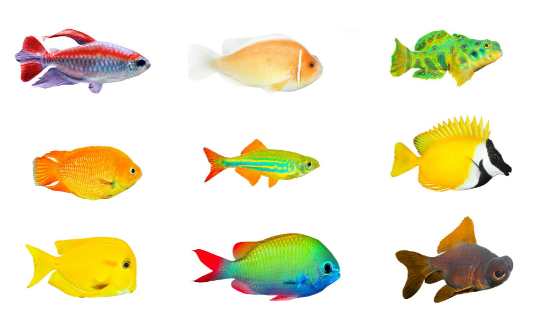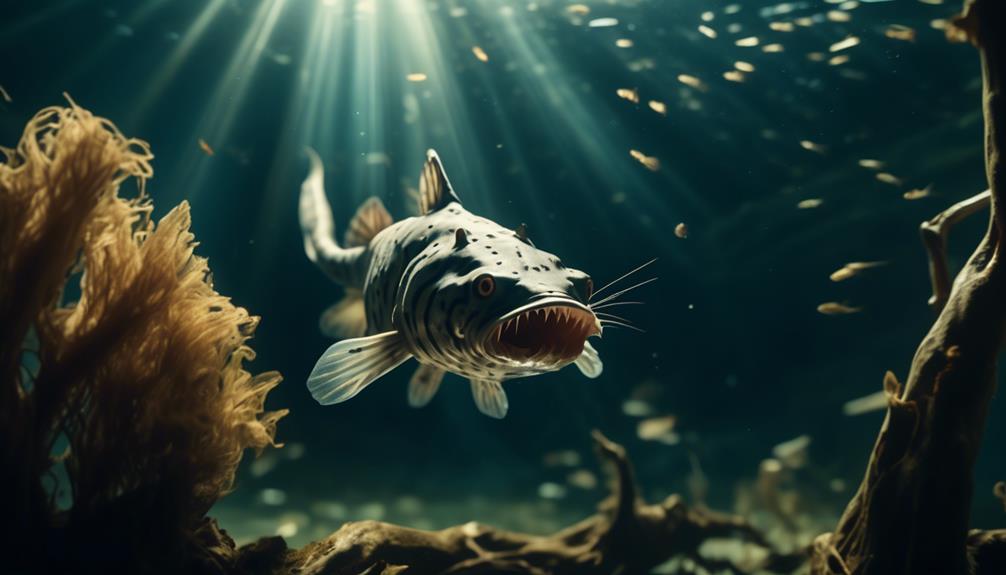
Have you ever marveled at the incredible ability of catfish to thrive in diverse environments?
Imagine a catfish species that can survive in both freshwater rivers and salty oceans. Sounds impossible, right?
Well, prepare to have your mind blown as we take a closer look at the fascinating world of catfish and their astonishing adaptability.
From their unique physical features to their remarkable ability to navigate through various habitats, these creatures have an exceptional story to tell.
But that’s just the beginning – there’s so much more to uncover about these captivating creatures, so join us as we unravel the mysteries of the catfish world.
Key Takeaways
- Catfish are a diverse group of fish known for their unique physical characteristics and ability to thrive in various aquatic habitats.
- They have adaptations such as camouflage and whisker-like barbells that assist in their survival and finding food in different environments.
- Most catfish species are omnivores and have a hardy nature, making them adaptable to different water conditions in aquariums.
- Breeding catfish in a home aquarium can be challenging due to their complex spawning behavior and specific breeding requirements.
Catfish Classification
Catfish are classified into various species based on their unique physical characteristics and habitats. This classification helps to categorize and understand the different types of catfish that exist in the world.
Each species has its own distinctive traits, such as whisker-like barbells, thick leathery skin, and bony and spine-like rays on their fins. These physical features not only contribute to their appearance but also play a role in their survival and adaptation to their environments.
Additionally, the habitats in which catfish are found vary greatly, ranging from freshwater rivers and lakes to swamps and even underground caves. This diversity in habitats further adds to the rich and fascinating world of catfish and makes them an intriguing group of fish to study and appreciate.
Catfish Habitat and Adaptability
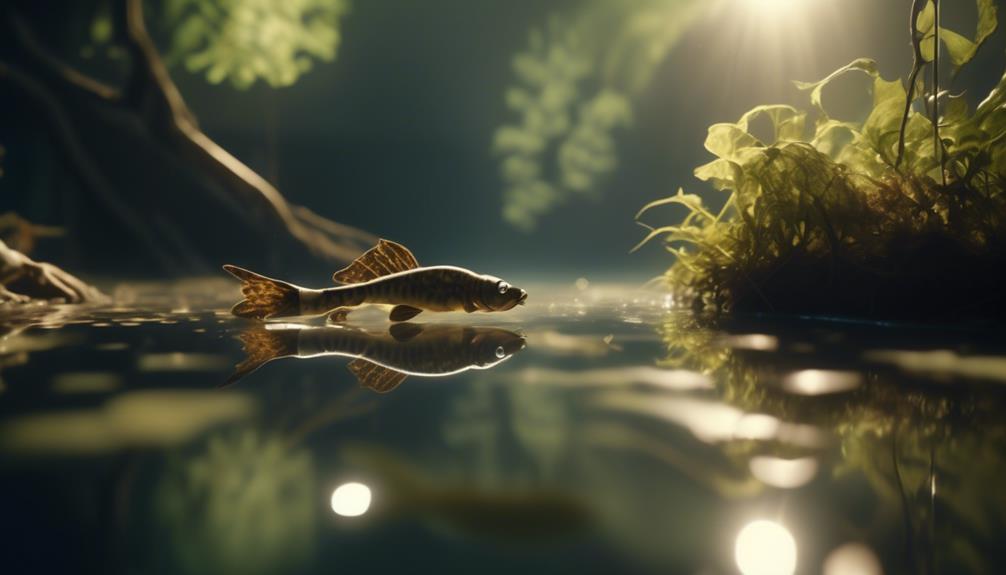
With their diverse range of habitats and remarkable adaptability, catfish have proven to be remarkably resilient in various aquatic environments. They’ve managed to thrive in lakes, rivers, streams, and even underground caves.
Here are three fascinating ways in which catfish adapt to their surroundings:
- Camouflage: Catfish have evolved to blend in with their surroundings, allowing them to remain hidden from predators. Their mottled skin coloration helps them blend in with the sandy or muddy bottoms of their habitats.
- Sensory perception: Catfish possess an incredible sense of touch. Their whisker-like barbells, known as maxillary barbels, are covered in taste buds and help them locate food in dark or murky waters.
- Air breathing: Some species of catfish have the ability to breathe air. They possess a specialized organ called a labyrinth organ, which allows them to extract oxygen from the atmosphere when oxygen levels in the water are low.
These adaptations have enabled catfish to thrive and survive in a wide range of environments, making them truly fascinating creatures.
Catfish Feeding Habits
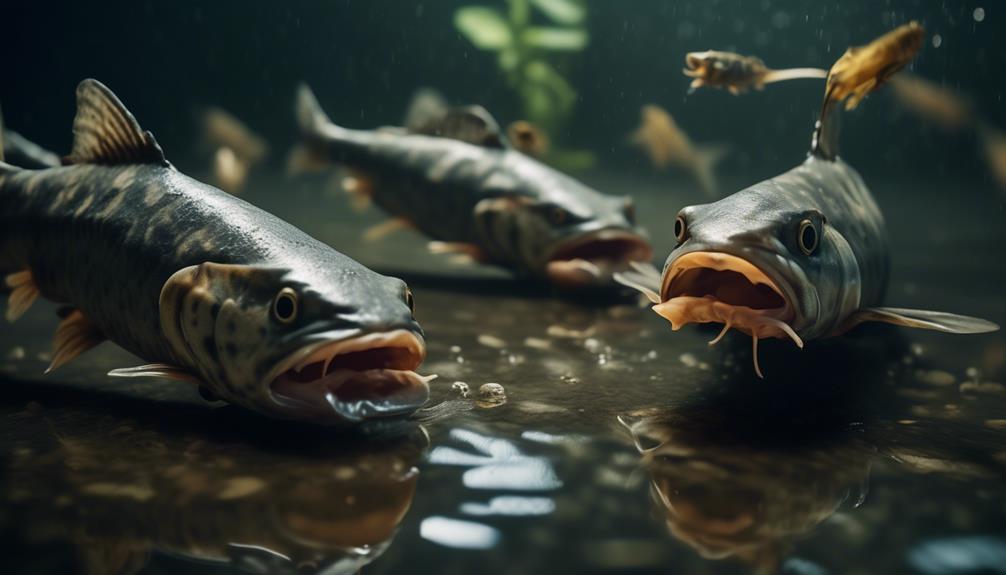
To understand the feeding habits of catfish, it is important to consider their diverse diet and adaptability to different water conditions. Most species of catfish are omnivores and have a diet that is pellet or algae disk based. They are known to be scavengers, feeding on algae, and some carnivorous species may even eat smaller tank mates. Catfish are hardy and adaptable, capable of thriving in a wide range of water conditions. They are able to adjust to different types of food and can survive in both freshwater and brackish water environments. Catfish have a unique feeding behavior, using their barbells to locate food on the bottom of the tank. Their ability to adapt and their varied diet make them fascinating creatures to observe in the aquarium.
| Feeding Habits | Description |
|---|---|
| Diet | Pellet or algae disk based |
| Scavengers | Feed on algae |
| Carnivorous species | May eat smaller tank mates |
| Adaptability | Hardy and adaptable to different water conditions |
Catfish Breeding Challenges
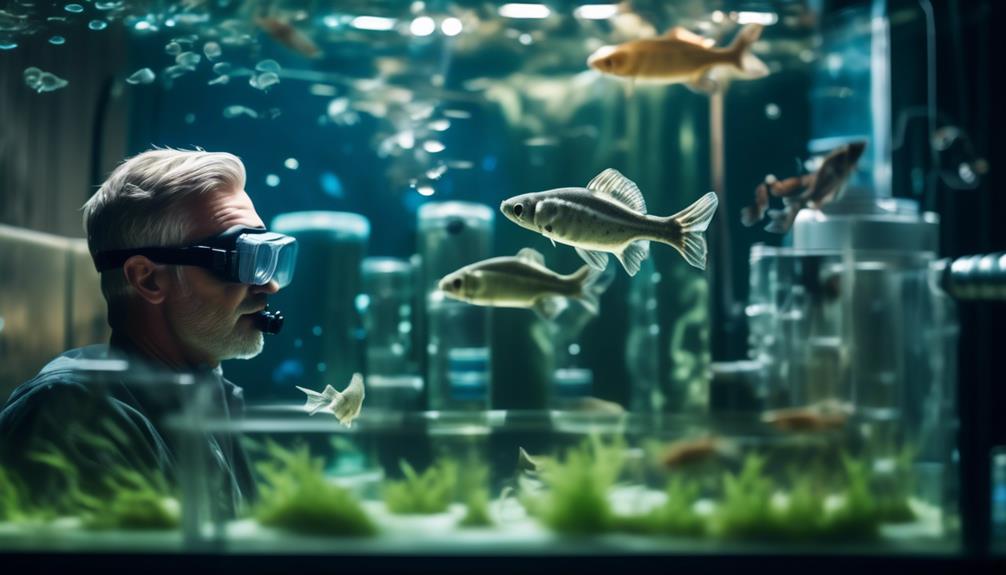
Understanding the unique challenges of breeding catfish can be an intriguing exploration for aquarium enthusiasts. However, it’s important to note that breeding catfish in a home aquarium is virtually unheard of.
Despite their popularity as pets, catfish breeding poses several difficulties. These challenges include:
- Complex spawning behavior: Catfish have specific requirements for breeding, such as the need for a separate breeding tank with appropriate water conditions and hiding spots.
- Compatibility issues: Finding compatible pairs can be challenging, as some species may not breed in captivity or have specific breeding requirements.
- Parental care: Catfish are known for their parental care, which can be demanding for aquarists. Caring for the eggs and fry requires specialized knowledge and equipment.
Breeding catfish successfully requires dedication, knowledge, and a thorough understanding of their natural behaviors.
Popular Catfish Species for Aquariums
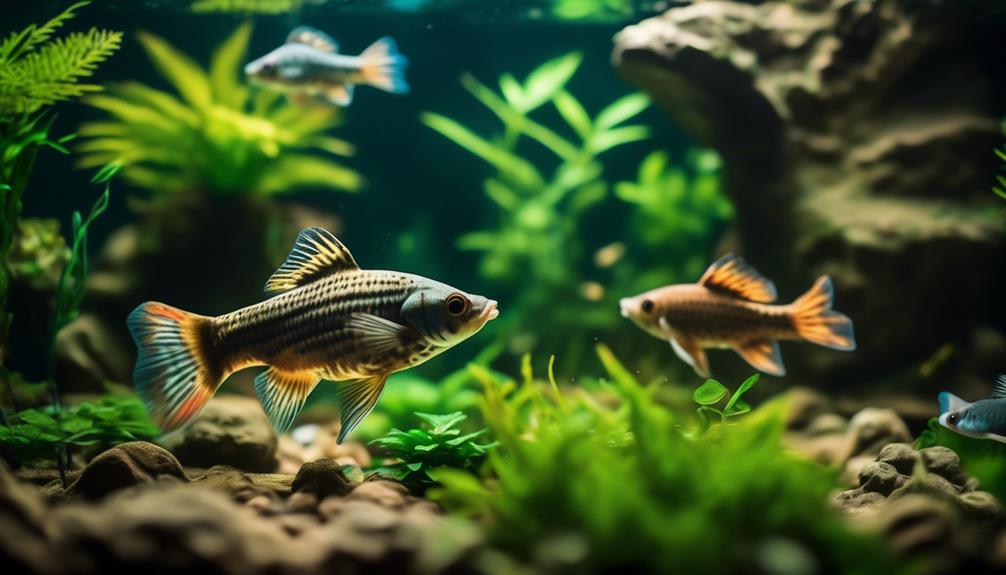
One popular choice for aquarium enthusiasts is the variety of catfish species available. These freshwater fish make great additions to large aquariums, typically requiring a tank size of 50 gallons or more. Catfish are known for their non-aggressive temperament and can peacefully coexist with other species such as Koi, Giant Gourami, Oscars, and Pacu.
Their unique features, including whisker-like barbells and thick leathery skin, add intrigue to any aquarium. Catfish come in a range of colors, including shades of white, pink, brown, yellow, grey, and black. They’re also adaptable to a wide range of water conditions, although sudden changes can be stressful for them.
With their hardy nature and interesting behaviors, catfish are a popular choice for aquarium enthusiasts.
Tips for Caring for Catfish in an Aquarium
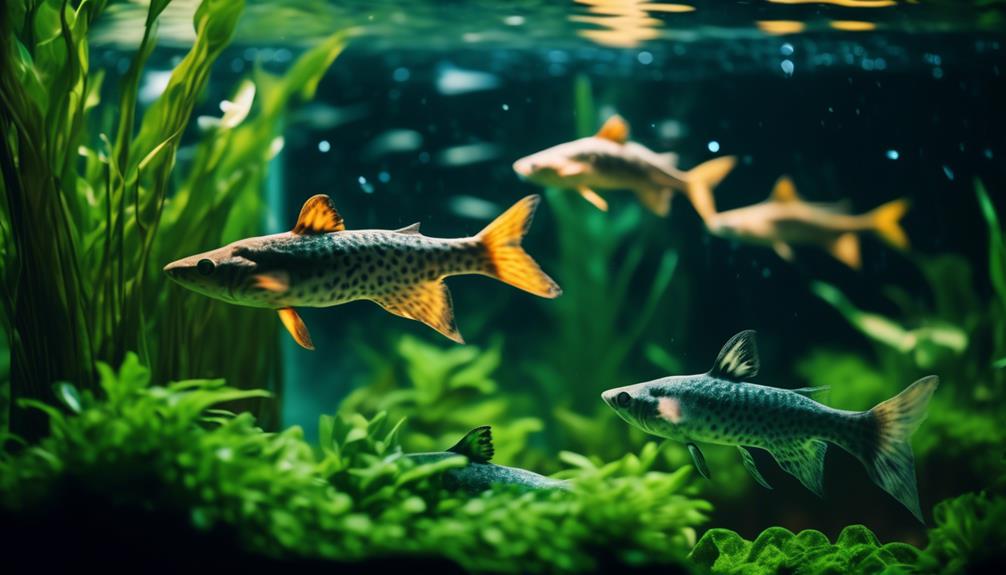
Taking care of catfish in an aquarium is essential to ensure their well-being and maintain a thriving aquatic environment. To provide the best care for your catfish, consider the following tips:
- Create a spacious environment: Catfish are large creatures and need plenty of space to swim and explore. A large aquarium, preferably 50 gallons or more, will provide them with the room they need to thrive.
- Mimic their natural habitat: Catfish prefer soft substrates like sand or smooth gravel. By recreating their natural environment, you can make them feel more comfortable and reduce stress.
- Choose suitable tank mates: Catfish are non-aggressive and prefer peaceful tank mates that won’t stress them out. Consider other species of catfish, Koi, Giant Gourami, Oscars, or Pacu as suitable companions.
Frequently Asked Questions
What Are Some Common Diseases That Catfish Are Prone to in an Aquarium?
Some common diseases catfish are prone to in an aquarium include bacterial infections, fungal infections, parasites, and swim bladder disorders. It’s important to maintain proper water conditions, provide a balanced diet, and monitor their health regularly.
Can Catfish Be Kept With Aggressive or Territorial Fish Species?
No, catfish cannot be kept with aggressive or territorial fish species. They are non-aggressive and prefer peaceful tank mates. Mixing them with aggressive fish may lead to stress or harm.
How Long Does It Typically Take for Catfish to Reach Their Full Size?
It typically takes catfish a few years to reach their full size, depending on the species. Factors like diet, water conditions, and genetics can also affect their growth rate.
Are There Any Special Considerations or Precautions to Take When Handling Catfish?
When handling catfish, be cautious of their barbells which can cause painful stings. Use a net or wet hands to avoid damaging their delicate skin. Take care not to stress or harm them.
What Are Some Signs That Indicate a Catfish Is Stressed or Not Thriving in the Aquarium Environment?
If your catfish is stressed or not thriving in the aquarium, look for signs such as decreased appetite, hiding, lethargy, abnormal swimming patterns, and changes in coloration. Take steps to address the issue and improve their well-being.
What are the similarities and differences between catfish and eels in terms of their behavior and habitat?
Catfish and eels share similar bottom-dwelling behaviors in their habitats. They both prefer murky, slow-moving waters with plenty of hiding spots. However, the fascinating world of eels includes their ability to swim backward, a trait not seen in catfish. Eels also tend to dwell in saltwater, while catfish are typically found in freshwater environments.
Conclusion
So, if you’re ready to add a touch of tranquility to your aquarium, look no further than the captivating world of catfish.
With their unique characteristics, diverse species, and peaceful temperament, these freshwater creatures are a joy to care for.
From their barbells to their spine-like rays, catfish are truly one-of-a-kind.
So, dive in and uncover the secrets of these mesmerizing creatures and create a captivating aquatic habitat like no other.




